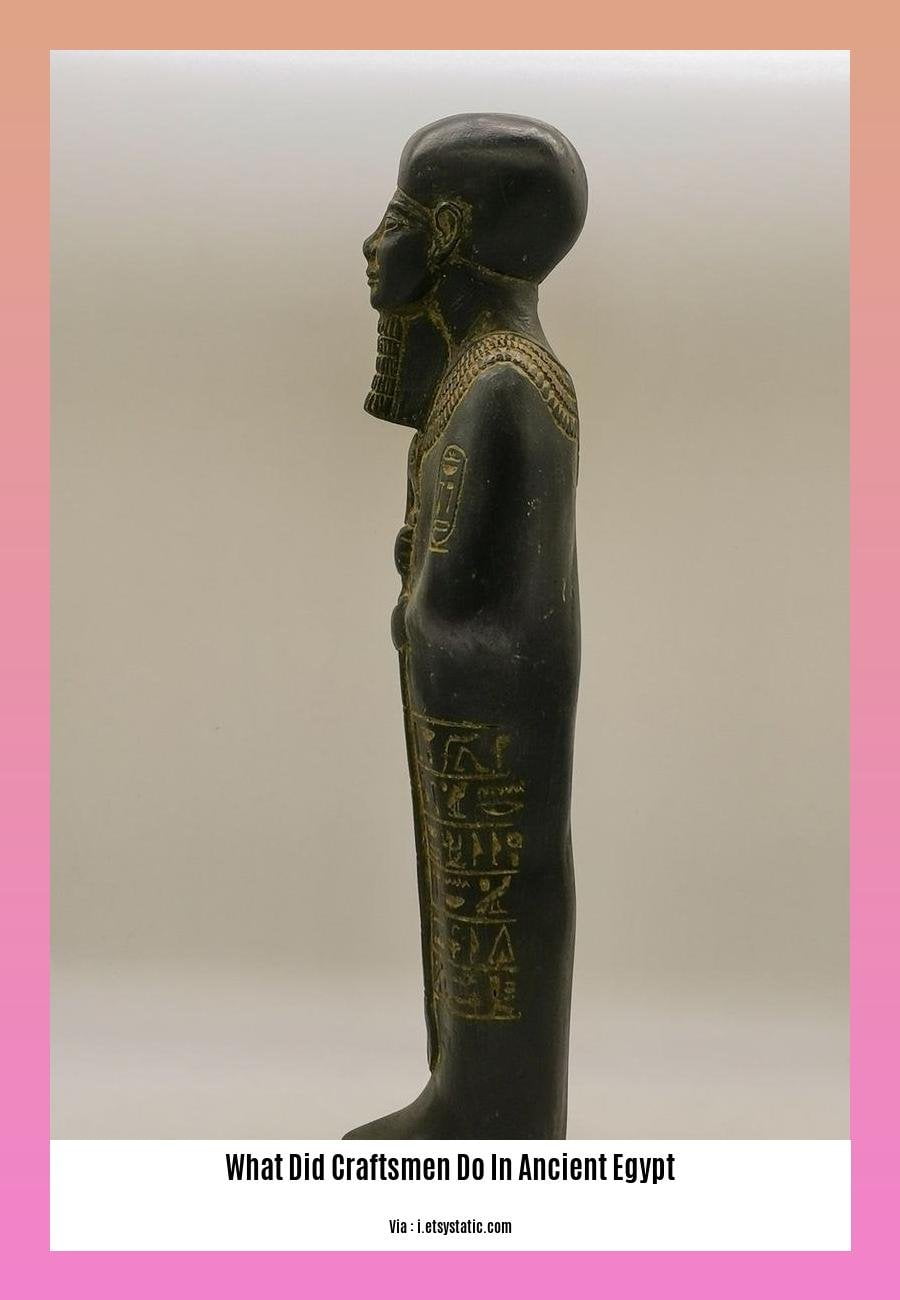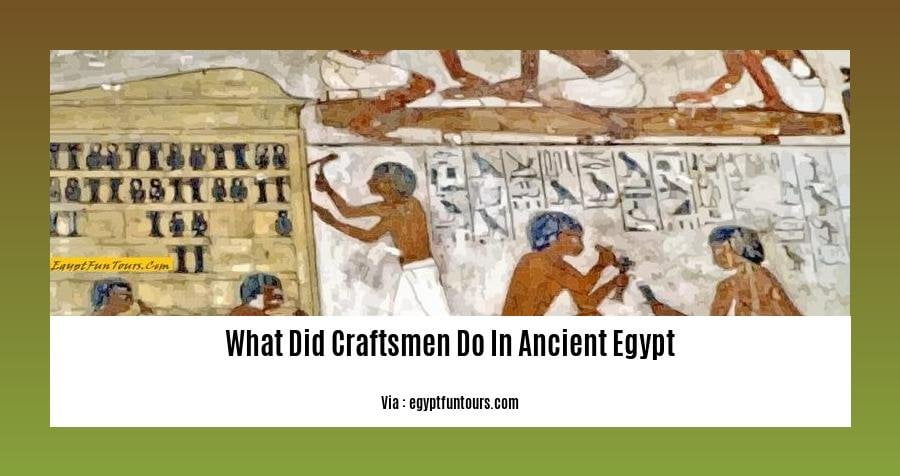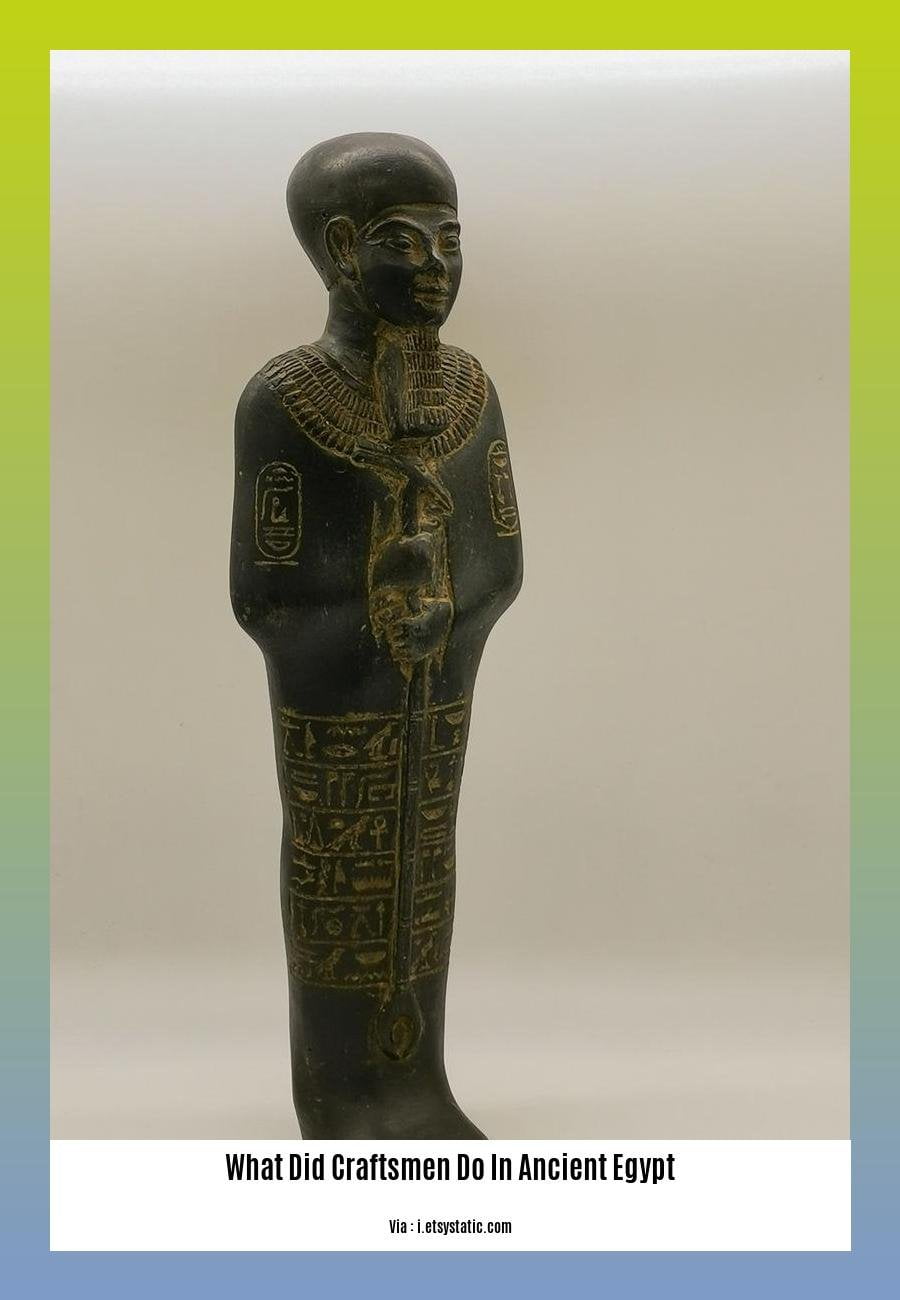Take a captivating journey into the skilled world of ancient Egyptian craftsmen in [What Did Craftsmen Do in Ancient Egypt? A Journey into Their Skilled World]. Discover the remarkable techniques, materials, and artistic styles they employed to create exquisite artifacts, monuments, and everyday objects.
Key Takeaways:
- Artisans created goods for everyday life, religious events, and building projects.
- They possessed diverse craftsmanship skills, including sculpting, metalworking, painting, and carpentry.
- Their skills allowed for the creation of protective amulets, pottery, paintings, and armaments.
- Official workshops often served as collaborative spaces for artisans.
What Did Craftsmen Do in Ancient Egypt?

In the heart of ancient Egypt, skilled craftsmen played a vital role in shaping the civilization’s rich culture and material world. They were masters of various crafts that contributed to daily life, religious rituals, and monumental construction projects.
Crafting a Civilized World
1. Builders of Temples and Tombs:
- Craftsmen were the architects of Egypt’s iconic temples and tombs, transforming colossal stone blocks into majestic structures.
- Their meticulous attention to detail and engineering prowess ensured the stability and longevity of these awe-inspiring monuments.
2. Sculptors of Gods and Pharaohs:
- With chisels and hammers, craftsmen immortalized the divine and the royal in stone, creating exquisite statues of gods and pharaohs.
- Their artistry captured the essence of power, divinity, and the intricate details of ancient Egyptian garments and accessories.
3. Artisans of Jewelry and Amulets:
- Craftsmen skillfully crafted exquisite jewelry, amulets, and talismans from precious metals and gemstones.
- These adornments served both decorative and protective purposes, reflecting the ancient Egyptians’ belief in the power of symbols and divine protection.
4. Weavers of Linen and Garments:
- Craftsmen wove intricate textiles and garments from linen, a versatile material derived from flax plants.
- Their looms produced clothing, tapestries, and sails, essential for daily life and religious ceremonies.
5. Potters of Functional and Artistic Vessels:
- Craftsmen shaped clay into functional pottery and artistic masterpieces, adorning them with vibrant colors and intricate designs.
- Their vessels served a variety of purposes, from storing food and liquids to holding offerings in religious rituals.
Collaboration and Legacy
Craftsmen in ancient Egypt often worked in official workshops, collaborating on grand projects under the supervision of master craftsmen. They shared their skills and knowledge, ensuring the continuation of traditional techniques and artistic styles. Their dedication and expertise laid the foundation for ancient Egypt’s remarkable craftsmanship, which continues to captivate and inspire people worldwide.
Conclusion
The craftsmen of ancient Egypt were the backbone of the civilization’s material culture. Their skills, creativity, and dedication shaped everything from monumental structures to everyday objects, leaving an enduring legacy that continues to fascinate and inform us about this ancient civilization.
The ancient Egyptians employed a diverse range of tools in their daily lives, from simple hand tools to complex machinery. Tools in ancient Egypt
Beyond the familiar swords and spears, ancient Chinese warriors wielded an array of unorthodox weapons, each designed for specialized combat situations. Unusual ancient Chinese weapons
Embark on a journey through ancient Egypt to uncover the remarkable skills and contributions of its craftsmen, whose ingenuity shaped the civilization’s development. What do craftsmen do in ancient Egypt
Delve into the captivating history of ancient Egypt and discover the significance of its capital city, a hub of power, culture, and architectural marvels. What is the capital of ancient Egypt
The significance of craftsmanship in religious practices and daily life
Craftsmanship in ancient Egypt held profound significance, transcending its role in producing goods for practical use. It was a fundamental aspect of religious practices and daily life, shaping the civilization’s spiritual beliefs, cultural identity, and social structure.
Key Takeaways:
Craftsmanship Played a Pivotal Role in Religious Ceremonies: Artisans meticulously crafted sacred objects, ceremonial artifacts, and temple decorations, contributing to a rich tapestry of rituals and practices that honored deities and ensured cosmic balance.
Craftsmanship Embodied Spiritual Beliefs: Objects crafted with exceptional skill and artistry were imbued with spiritual significance, acting as conduits between the earthly and divine realms. The craftsmanship’s beauty and symbolism served as expressions of faith and devotion to various deities.
Craftsmanship Reflected Social Hierarchy: Craftsmen held a revered status in society, particularly those specializing in intricate and specialized crafts. Their skills were highly valued, with master craftsmen attaining positions of great influence and prestige within the social hierarchy.
Craftsmanship Fostered Community and Unity: The collaborative nature of craftsmanship brought people together, promoting a sense of communal purpose. Artisans shared knowledge, techniques, and stories, fostering a sense of unity and cultural identity.
Craftsmanship Preserved History and Cultural Traditions: The meticulous attention to detail and adherence to traditional techniques ensured the preservation of ancient Egypt’s rich cultural heritage. Craftsmanship served as a tangible link to the past, carrying forward traditions and beliefs from generation to generation.
The Craftsman’s Role in Religious Ceremonies:
The craftsmanship in ancient Egypt was not just about creating beautiful objects, but it also played a vital role in religious ceremonies and rituals. Artisans were responsible for creating the sacred objects, ceremonial artifacts, and temple decorations that were essential for these ceremonies. These objects were not just functional items, but they were imbued with spiritual significance and were believed to have the power to connect the earthly and divine realms.
The Craftsman as an Artist:
Craftsmen in ancient Egypt were not just skilled workers but also artists. They used their skills and creativity to create objects that were both beautiful and functional. Their work reflected the religious beliefs and cultural values of their time, and their creations continue to be admired and studied today.
Sources:
Smithsonian – Artisanry in Ancient Egypt
National Geographic – The Craftsmen of Ancient Egypt
Techniques and materials used by Egyptian craftsmen

Imagine yourself transported back in time to ancient Egypt, where skilled craftsmen worked tirelessly to shape materials into functional and aesthetically pleasing objects. Their expertise extended far beyond mere craftsmanship; they were artists, innovators, and storytellers. Let’s delve into their world and uncover the techniques and materials they employed to create masterpieces that have stood the test of time.
Techniques:
- The Art of Stoneworking: Egyptian craftsmen wielded chisels and hammers to sculpt magnificent structures and statues from limestone, granite, and sandstone. Their attention to detail is evident in the intricate carvings adorning temple walls and the lifelike features of stone sculptures.
- Metalworking Mastery: Using furnaces and anvils, craftsmen transformed metals like gold, silver, and copper into exquisite jewelry, weaponry, and decorative objects. The intricate filigree work and delicate inlay techniques showcased their exceptional skill and artistry.
- Pottery: A Canvas for Creativity: On their potter’s wheels, craftsmen skillfully shaped clay into functional vessels and decorative pieces. They adorned these pots with vibrant colors, intricate patterns, and hieroglyphic inscriptions, transforming them into works of art.
- Weaving: Threads of History: Using looms, craftsmen interlaced linen fibers to create garments, tapestries, and sails. Their intricate designs and vibrant hues added a splash of color to the bustling Egyptian streets.
Materials:
- Stone: Foundation of Monuments: Limestone, granite, sandstone, and basalt were the primary stones used by Egyptian craftsmen. These sturdy materials provided the foundation for temples, tombs, and statues, ensuring their longevity.
- Metals: Adorning and Empowering: Gold, silver, and copper were the most commonly used metals. Gold’s allure made it ideal for jewelry and religious objects, while silver and copper served practical purposes in utensils, weapons, and tools.
- Clay: Shaping Utility and Beauty: The Nile River’s rich clay provided an abundant resource for pottery. Craftsmen molded clay into various shapes, from utilitarian vessels to ornate figurines, showcasing their creativity and technical prowess.
- Wood: Life from Nature: Acacia, tamarisk, sycamore fig, and cedar were among the woods employed by Egyptian craftsmen. These woods were used for furniture, boats, coffins, and a myriad of other objects, bringing warmth and elegance to everyday life.
- Faience: A Versatile Medium: Faience, a quartz-based material, was highly prized for its versatility. Craftsmen could mold it into small objects, create colorful glazed tiles, and even fashion it into jewelry, demonstrating their adaptability and artistry.
Key Takeaways:
- Egyptian craftsmen possessed remarkable skills in stoneworking, metalworking, pottery, and weaving.
- They utilized various materials, including stone, metal, clay, wood, and faience, to create functional and aesthetically pleasing objects.
- Their técnicas empleadas en la talla de piedra incluyeron el uso de cinceles y martillos para esculpir intrincadas obras de arte en piedra caliza, granito y arenisca.
- Craftsmanship in ancient Egypt was a highly respected profession, with craftsmen holding important positions in society.
- Many of the artifacts created by ancient Egyptian craftsmen can still be seen today in museums around the world.
Relevant Sources:
[1].
[2].
Preservation and restoration of ancient Egyptian craftsmanship
Hey there, history enthusiasts, welcome to a journey through the fascinating world of ancient Egyptian craftsmanship, a testament to the enduring legacy of skilled artisans in one of the world’s oldest civilizations.
Key Takeaways:
Craftsmen held a revered position, creating everything from humble pottery to grandiose tombs and temples.
Preservation involves stabilizing and protecting existing artifacts, ensuring their longevity for future generations.
Restoration goes beyond preserving by actively repairing and reconstructing them to their former glory.
Preserving and restoring Egyptian craftsmanship not only protects these relics but keeps alive the spirit of their makers.
But wait, there’s more to discover! The preservation and restoration of ancient Egyptian craftsmanship is a noble pursuit that not only safeguards these precious artifacts but also allows us to connect with the past. Let’s delve deeper into this fascinating realm together.
Okay, so how do we preserve these ancient treasures? Well, it starts with careful examination and documentation, understanding the materials used, their condition, and the factors causing deterioration. From there, it’s all about implementing measures to stabilize and protect the artifacts.
Restoration, on the other hand, takes things a step further. It involves repairing and reconstructing damaged or incomplete pieces, restoring them to their original state or as close as possible. It’s like giving these relics a second chance at life, allowing us to appreciate their beauty and craftsmanship once again.
Preserving and restoring ancient Egyptian craftsmanship not only protects these relics but also keeps alive the spirit of their makers. It’s a way of honoring their skills, ingenuity, and dedication to their craft. Isn’t it amazing how their creations continue to spark awe and wonder in us today?
Well, friends, that’s a quick peek into the world of ancient Egyptian craftsmanship preservation and restoration.
Let’s wrap things up with a few fascinating facts:
The Rosetta Stone was instrumental in deciphering ancient Egyptian hieroglyphs, unveiling the secrets of their written language.
The Valley of the Kings is a treasure trove of beautifully preserved tombs, offering a glimpse into the lives of Egypt’s pharaohs.
Remember, these artifacts are priceless, and their preservation is a collective responsibility. Join the effort to keep this ancient heritage alive for future generations!
Sources:
FAQ
Q1: What were the primary roles and responsibilities of craftsmen in ancient Egypt?
A1: Craftspeople in ancient Egypt held a crucial role in society, tasked with producing a vast array of goods essential for daily life, religious ceremonies, and construction projects. Their skills spanned various crafts, including sculpting, metalworking, painting, and carpentry, enabling them to create everything from protective amulets to pottery, paintings, and armaments.
Q2: What kind of items did ancient Egyptian craftsmen create?
A2: Craftsmen in ancient Egypt were responsible for producing diverse items that played vital roles in everyday life. They crafted pottery for storage, cooking, and transportation purposes. Jewelry, amulets, and other decorative objects were also among their creations. Additionally, they constructed furniture, boats, and various tools necessary for daily activities.
Q3: How did craftsmen collaborate to produce goods in ancient Egypt?
A3: Collaboration was an integral aspect of craftsmanship in ancient Egypt. Craftsmen often worked together in official workshops, where they combined their expertise to produce intricate and elaborate items. This collaborative approach facilitated the sharing of knowledge, techniques, and resources, resulting in exceptional craftsmanship and productivity.
Q4: What materials did ancient Egyptian craftsmen use to create their masterpieces?
A4: Ancient Egyptian craftsmen utilized a wide range of materials in their creations. Stones, such as limestone, granite, and basalt, were commonly used for sculpting and construction. Wood, including acacia, tamarisk, and sycamore fig, was employed for furniture, boats, and other objects. Metals, like gold, silver, and copper, were crafted into jewelry, tools, and decorative elements. Additionally, faience, a quartz-based medium, was used for creating small objects and figurines.
Q5: What was the social status of craftsmen in ancient Egypt?
A5: Craftsmen in ancient Egypt held a respected position in society, being recognized for their exceptional skills and artistic talents. They were considered socially superior to common laborers and were often part of the middle class, alongside other skilled workers like physicians. This elevated status afforded them certain privileges and allowed them to pursue their craft with pride and dedication.












